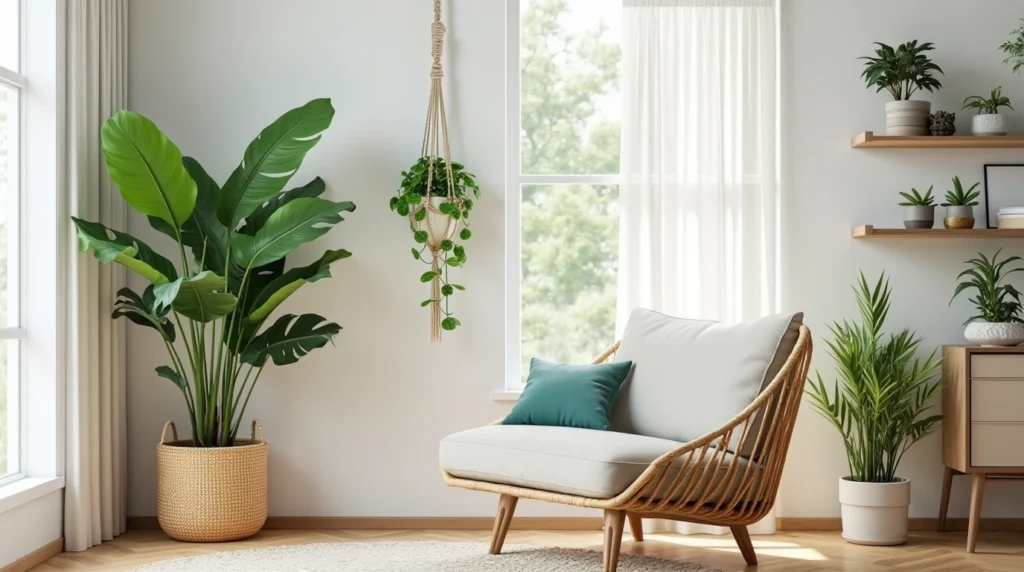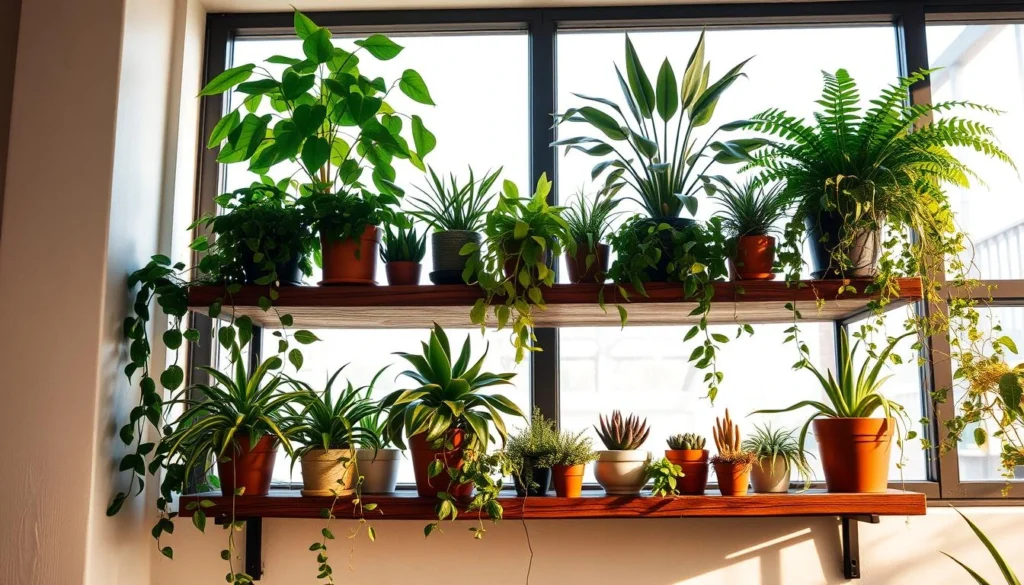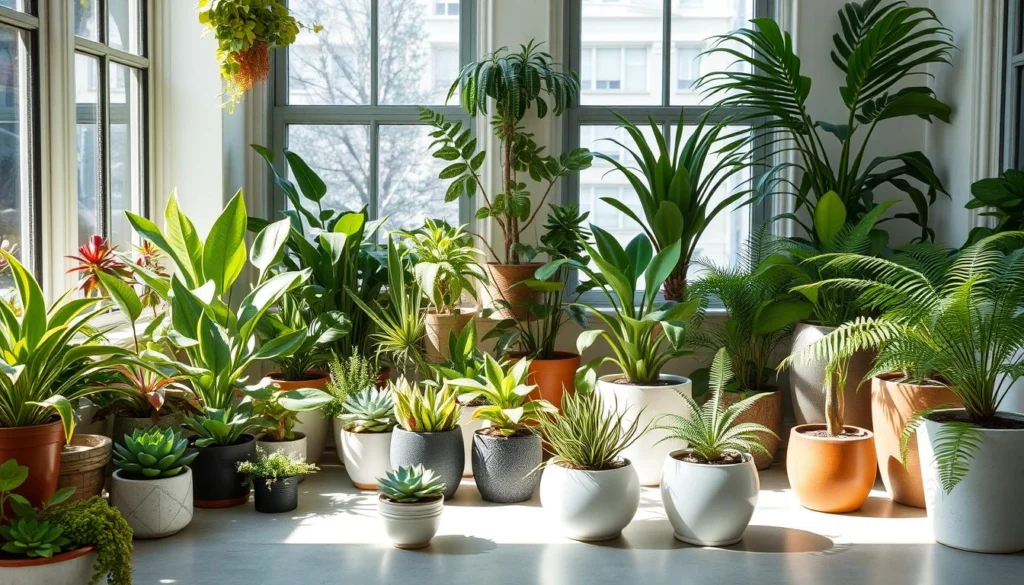
Do you feel like you can’t add greenery to your home because of limited space? You don’t have to give up on greenery just because your space is small. With the right selection of indoor plants for small spaces, you can bring life and beauty into even the tiniest corners of your home.
Choosing the right plants can make a big difference when space and time are tight. Pick low-maintenance, compact, and vertical plants. They take up just a little space on your desk, kitchen shelf, or tabletop.
These space-saving solutions do more than just look good. They purify the air and lift your mood. They also add natural beauty to your home. In this article, we’ll look at the top picks for small space indoor plants. We’ll also give you care tips to help them flourish.
Table of Contents
Why Plants Are Essential for Small Living Spaces
Compact indoor plants can change the game for small living spaces. They purify the air, improve health, and have a psychological impact. This makes small areas feel bigger and less stressful.
Adding plants to your small space can greatly improve your well-being. Let’s look at how plants can make your living space better.
Health Benefits of Indoor Greenery
Indoor plants improve air quality by removing pollutants. This makes your environment healthier. They also help reduce stress levels and can ease anxiety and depression symptoms.
Psychological Impact of Plants in Confined Areas
Plants in small spaces have a big psychological impact. They make areas feel more welcoming and can reduce claustrophobia. The calming effect of greenery boosts your mood and well-being.
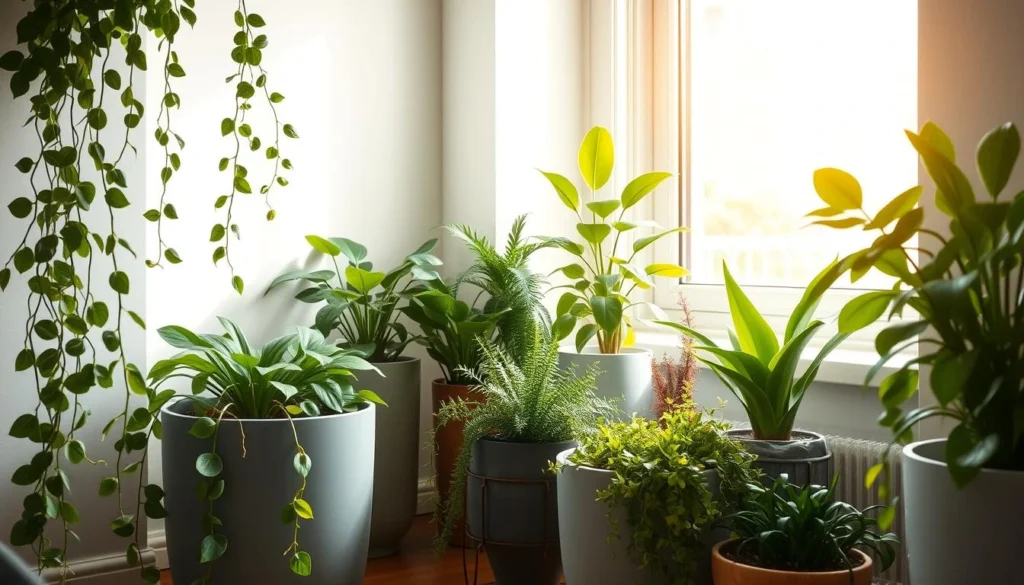
How Plants Can Make Small Spaces Feel Larger
Placing plants wisely in small spaces can make them seem bigger. Using vertical elements like wall-mounted planters or hanging baskets draws the eye upwards. This makes the area feel more open.
Best Indoor Plants for Small Spaces: Top Picks
Choosing the right indoor plants for small spaces can really make a difference. You don’t need a big garden to enjoy greenery. There are many plants that do well in tight spots.
Compact Succulents and Cacti
Compact succulents and cacti are great for small spaces. They need little care and can store water. They come in many shapes and sizes, perfect for adding greenery.
Haworthia and Echeveria Varieties
Haworthia and Echeveria are top picks for small spaces. They are small, with Haworthia growing in a rosette pattern. Echeveria has striking, fleshy leaves.
Mini Cactus Collections
Mini cacti are perfect for small spaces. They need little water and add whimsy to your decor.
Petite Trailing Plants
Petite trailing plants are great for hanging baskets or climbing walls. They make the most of your space.
String of Pearls and String of Hearts
String of Pearls and String of Hearts are easy to care for. They add a delicate touch to any room.
Pothos and Philodendron Varieties
Pothos and Philodendron are versatile and low-maintenance. They thrive in different lighting, making them perfect for small spaces.
Miniature Flowering Varieties
Miniature flowering plants add color to small spaces. They brighten up even the most compact areas.
African Violets and Mini Orchids
African Violets and mini orchids are beautiful and small. They thrive in indoor conditions.
Peace Lilies and Anthuriums
Peace Lilies and Anthuriums have elegant white blooms. They purify the air, making them great for indoor spaces.
| Plant Type | Lighting Needs | Watering Needs |
|---|---|---|
| Compact Succulents | Bright Light | Infrequent |
| Petite Trailing Plants | Medium to Bright Light | Regular |
| Miniature Flowering Varieties | Bright Light | Regular |
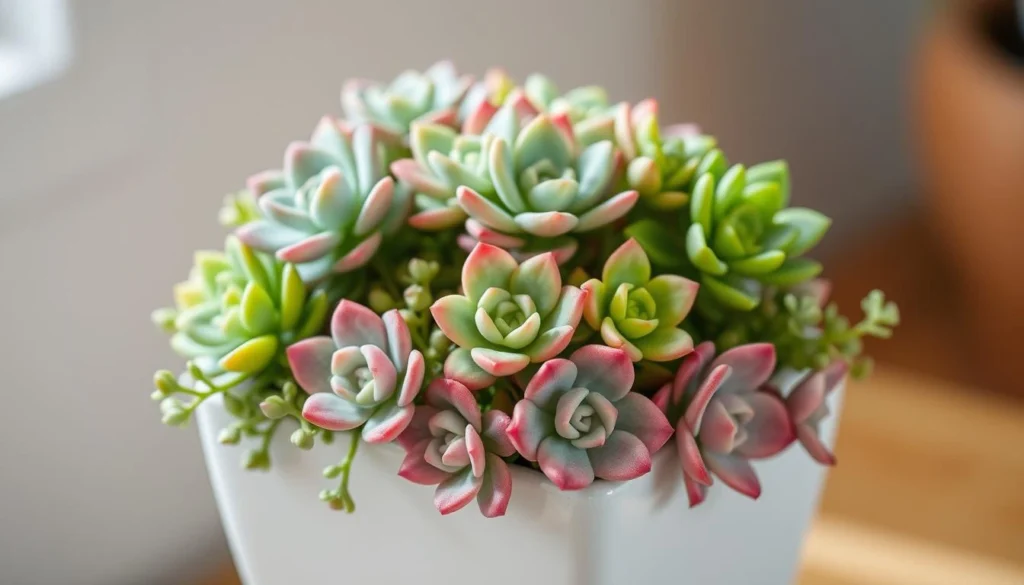
Space-Saving Plant Options by Light Conditions
Lighting is key when picking plants for small spaces. Knowing your home’s light is essential for the right plants.
Low-Light Champions for Dark Corners
Dark corners can be a challenge. But, there are plants that do well in low light. They’re great for spots with little natural light.
Snake Plants and ZZ Plants
Snake Plants and ZZ Plants love low light. They’re also easy to care for, making them perfect for those who are always on the go.
Chinese Evergreen and Cast Iron Plant
Chinese Evergreen and Cast Iron Plant are also good for low light. They look elegant and can handle dim conditions.
Medium-Light Plants for Average Rooms
Rooms with moderate light have many plant options. They can bring life and color to your space.
Peperomia Varieties and Prayer Plants
Peperomia and Prayer Plants do well in medium light. They come in various colors and patterns, making your space more interesting.
Ferns and Calatheas
Ferns and Calatheas also prefer medium light. They help create a lush, green feel in your home.
Bright Light Lovers for Sunny Windowsills
Sunny windowsills are ideal for growing many plants. The bright light is perfect for them.
Succulents and Jade Plants
- Succulents love bright light.
- Jade Plants do well in sunny spots.
Herbs and Small Citrus Plants
Herbs like basil and mint, and small citrus plants like lemons and limes, grow well in bright light. They’re useful and fragrant.
Vertical and Hanging Solutions for Tiny Apartments
You can make the most of your small apartment by using vertical and hanging solutions for your plants. This method not only saves space but also brings greenery to your living area.
Wall-Mounted Plant Systems
Wall-mounted plant systems are great for tiny apartments. They don’t take up floor space. You can customize them to fit your wall and hold many plants, making a lush display.
Hanging Planters That Maximize Space
Hanging planters are another smart choice for small apartments. They hang from ceilings or walls, adding beauty while keeping plants off the floor. This is great for rooms with little floor space.
Corner Plant Stands and Shelving Ideas
Corner plant stands and shelving are perfect for corners. They can show off different plants, from flowers to succulents. This makes the most of your apartment’s layout.
Using these vertical and hanging solutions lets you enjoy plants in your small apartment. You’ll get better air quality and a more welcoming space.
Care Tips for Maintaining Plants in Limited Space
To keep your indoor plants thriving in small spaces, it’s essential to follow proper care tips. Maintaining healthy plants in limited areas requires attention to their specific needs. This includes watering, fertilizing, and pest control.
Watering Strategies for Small Containers
Watering is a critical aspect of plant care, even more so in small containers. Soil can dry out quickly in these spaces. Check the soil moisture by inserting your finger into the soil up to the first knuckle.
If it’s dry, it’s time to water. Use a watering can with a long spout to reach into tight spaces. Avoid getting water on the leaves to prevent fungal diseases.
Space-Efficient Fertilizing Methods
Fertilizing your plants in small spaces requires a balanced approach. Use a water-soluble fertilizer at half the recommended strength. This avoids burning the roots.
You can also consider using compost tea or worm casting as a natural alternative. Fertilize your plants during the growing season (spring and summer). Reduce or stop fertilizing during the dormant season (fall and winter).
Pest Management in Close Quarters
Pests can be a significant problem in small, enclosed spaces. Inspect your plants regularly for signs of pests like spider mites, mealybugs, or scale. Use neem oil or insecticidal soap to control infestations.
Isolate infected plants to prevent the problem from spreading. Maintain good air circulation around your plants. This prevents fungal diseases.
Common Mistakes to Avoid with Indoor Plants for Small Spaces
To enjoy indoor plants in small spaces, avoid common errors. Knowing how to pick and care for plants in tight spots is key. This knowledge helps you avoid common pitfalls.
Choosing Plants That Grow Too Large
Choosing plants that grow too big is a big mistake. Compact or dwarf varieties are perfect for small spaces. They need less pruning and won’t get too big.
Overwatering in Limited Ventilation Areas
Overwatering is a big problem, worse in poorly ventilated areas. It can cause root rot and other issues. Check the soil moisture before watering and make sure plants have good air flow.
Ignoring Plant Compatibility in Grouped Arrangements
When grouping plants, think about their compatibility. Some plants may fight for resources or have different needs. Choose plants with similar needs for a healthy indoor garden.
Avoiding these mistakes lets you create a beautiful indoor garden, even in tiny spaces. Paying attention to your plants’ needs and picking the right ones will make your indoor garden thrive.
Read More :
Best Indoor Plant Decor Ideas to Refresh Your Space
How to Style a Plant Shelf Like a Pro
Conclusion: Creating Your Perfect Small Space Oasis
You can turn your small living area into a peaceful oasis. Choose the right indoor plants and use space-saving solutions. Follow proper care tips to keep your plants healthy.
Compact plants like succulents and trailing varieties add greenery without taking up too much space. Use vertical and hanging solutions to make the most of your area. This includes wall-mounted plant systems and hanging planters.
With the right care, your plants will flourish. This creates a calm and inviting space. Starting your indoor gardening journey brings many benefits, like better air quality and improved mental health.
Creating your perfect small space oasis makes your living area more relaxing and rejuvenating. Enjoy the peace and beauty of your indoor garden.
FAQ
What are the best indoor plants for small spaces?
For small spaces, consider compact succulents, petite trailing plants, and miniature flowering varieties. These are great for small apartments, condos, or rooms with little space.
How do I choose the right plants for my small space?
Think about your space’s lighting, temperature, and humidity. Choose plants that are compact or trailing. They do well in small areas.
Can I grow plants in low-light conditions?
Yes, you can grow plants in low light. Plants like Chinese Evergreen, Pothos, and Snake Plants thrive in dark spots or rooms with little natural light.
How often should I water my plants in small containers?
Watering frequency depends on the plant, soil, and climate. Check soil moisture by finger test. Water only when it’s dry.
What are some space-saving ways to display my plants?
Use wall-mounted systems, hanging planters, and corner stands to save space. These add greenery to small areas without taking up much room.
How can I prevent overwatering in small spaces?
Regularly check soil moisture and avoid watering leaves or crowns. Use a well-draining potting mix to prevent waterlogged soil.
What are some common mistakes to avoid when growing indoor plants in small spaces?
Avoid choosing large plants, overwatering, and neglecting plant compatibility. These mistakes can harm your indoor garden. By avoiding them, you can create a thriving space.
Can I group multiple plants together in a small space?
Yes, group plants together if they need similar light and water. But ensure good air circulation to prevent pests and diseases.
